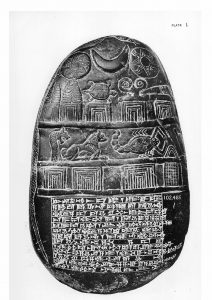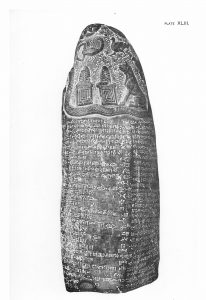
The Kudurru (akkadian: narû) is an important category of artifact found in Ancient Mesopotamia. These steles, often fashioned out of black limestone, begin to appear in the Kassite Period (1500-1155 BC). They seem to have been placed in temples for the purpose of placing the legal act described in their inscription under the protection of the gods.
Their upper part (and sometimes also their front) is embellished with a multitude of symbols, part of them on their own and others resting on pedestals. These symbols symbolise certain gods; the astral symbols that can be found on every kudurru are the sundisk, which stand for the Mesopotamian God of Sun and Law, Šamaš, the moon, symbolizing the Moon-God Sîn and the eight-pointed star for the Goddess of War and Love, Ištar. Other often occuring symbols are: the scorpion, standing for Išḫara, a protector of oaths, the dog, symbolising the healing Goddess Gula, and a spade, often on a pedestal, which stands for the City-God of Babylon, Marduk.
The inscriptions describe judicial processes, prototypically royal endowment of persons or institutions with land. The land endowed was accutely described, and the document included a list of witnesses of this legal action as well as a list of curses the destroyer of the contract of the stele would be afflicted by.

